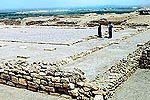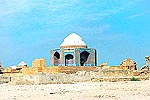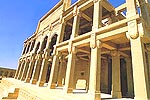It is believed that this was the place where Alexander the Great rested his legions after their long march. The remains of Thatta include the tombs, mausoleums and mosques. Some of them are in a good state of preservation. The remains of Thatta depicts their civilized sense.
 The surrounding region includes the
barren and rocky Kohistan area and the swampy deltaic land of the Indus.
Sugarcane is the chief crop; camel breeding is significant. Nearby
excavations reveal occupations dating from the first century B.C.
The surrounding region includes the
barren and rocky Kohistan area and the swampy deltaic land of the Indus.
Sugarcane is the chief crop; camel breeding is significant. Nearby
excavations reveal occupations dating from the first century B.C.
The Makli Hill near Thatta is the world largest graveyard spread over 15.5 sq. kms, having millions of graves. Here in eternal sleep lie kings, queens, Scholars, Philosophers and soldiers of a by-gone era-an era renowned for its culture and learning.
We can see the masterpieces of stone carvings over the gravestones and
mausoleums. These grave stones and mausoleum stones represent the
different era's and dynasties. There are monuments of Summa period
(14th to 16th centuries), the Tarkhan & Arghun period (16th
century), and the Moghul period (16th to 18th centuries). You can
examine the minute and delicate workmanship on the tombs of famous
Mughal governor's. The structure is strong and beautiful exemplifying
its immaculate beauty. The main stone used in the construction of these
monuments are; marble and granites which have a tendancy to last for
generation's. You could easily see a rhythmic construction in these
monuments.
There are monuments of Summa period
(14th to 16th centuries), the Tarkhan & Arghun period (16th
century), and the Moghul period (16th to 18th centuries). You can
examine the minute and delicate workmanship on the tombs of famous
Mughal governor's. The structure is strong and beautiful exemplifying
its immaculate beauty. The main stone used in the construction of these
monuments are; marble and granites which have a tendancy to last for
generation's. You could easily see a rhythmic construction in these
monuments.
The largest and the most impressive tomb among the tomb's is the tomb of Isa Khan Tarkhan who died in 1644. Isa khan had constructed this tomb in his lifetime. After a partial completion of that tomb, Isa khan cut off the hand's of most talented craftsmen, so that no other emperor could engage them to copy the same monument again. Besides the most preserved monuments are, the tomb's of Mirza jani Beg, Mirza Tughral beg and Diwan Shurfa Khan.
 3.22 km away from Thatta is the Shah
Jehan Mosque, which is the masterpiece of mughal construction. This
mosque was built by the constructor of Taj Mahal in 1647 A.D. Build
towards the middle of the 17th century, this sets a glorious example of
Muslim architecture and heritage. This mosque was build by Mir Abdullah
under the order of The Mughal emperor, Shah Jehan. Shah Jehan mosque is
a superb example of crafty tile work. Its 93 domes and 33 arches with
varying sizes add to their architectural beauty. The domes have been
exquisitely laid in a mosaic of radiating blue and white tiles. Thatta
with so much offering poses to be a prime choice of visitors.
3.22 km away from Thatta is the Shah
Jehan Mosque, which is the masterpiece of mughal construction. This
mosque was built by the constructor of Taj Mahal in 1647 A.D. Build
towards the middle of the 17th century, this sets a glorious example of
Muslim architecture and heritage. This mosque was build by Mir Abdullah
under the order of The Mughal emperor, Shah Jehan. Shah Jehan mosque is
a superb example of crafty tile work. Its 93 domes and 33 arches with
varying sizes add to their architectural beauty. The domes have been
exquisitely laid in a mosaic of radiating blue and white tiles. Thatta
with so much offering poses to be a prime choice of visitors.


